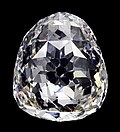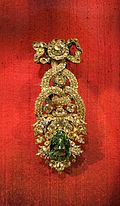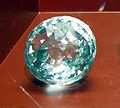The Golconda Diamonds are the Indian diamonds mined in a specific geographic area known as Godavari delta that used to be part of Golconda Sultanate (in the present day Andhra Pradesh and Telangana states of India). Golconda Fort (as a seat of Golconda Sultanate) is essentially the eastern part of modern Hyderabad. It became an important center for enhancement, skilled lapidary and trading, for which Golconda Diamond became synonymous with Golconda itself. The region is known for producing diamonds for nearly 2000 years and was the only known source of diamonds on earth until 17th century. They are Type IIa—(a high rank according to grading standards) diamonds and are devoid of nitrogen, they are large in size and weight around 0.875 carats (0.1750 g) carat, while most of those are known for their colourless clarity.
The Golconda region has produced some of the world’s most famous diamonds, including the colourless Koh-i-Noor (currently in the United Kingdom), the Nassak Diamond, the blue Hope Diamond (in the United States), the pink Daria-i-Noor (in Iran), the white Regent (France), the Dresden Green (Germany), and the colourless Orlov (Russia), Nizam and Jacob (India), as well as the now lost diamonds Florentine Yellow, Akbar Shah and Great Mogul.
The 17th century was the peak period of the Golconda diamond industry, with 38 mines in the region (of which Kollur Mine was the most popular), with 66,000 people working at a time in one mine. The output from all the mines in Golconda was estimated to be around 12,000,000 carats (2.4 t). Along with diamonds, the region also became a trade centre for metal-ware, pearls, spices and textiles-(Chintz).
History
Medieval records from Europe and the Middle East attest to India’s importance as the famed source of high quality diamonds. According to Jack Ogden – a scholar known for his publications on diamonds and the history of jewels, these records include those of Pliny, Marco Polo, Muhammed al-Idrisi and others from pre-12th century. They mention that India produced diamonds with “which the gems were engraved”. Beyond these sources, ancient texts of Buddhists, Hindus and Jains – such as the Arthashastra (2nd century BCE – 4th century CE), the Ratna Pariksha, the Puranas – mention cities and regions of India that produced diamonds. However, these names are difficult to link to modern geographical names. Recent studies identify a region south of Kurnool district, the area near Krishna river valley in and around NTR district, Palnadu district, Guntur district, the area near Godavari delta in Rampachodavaram and Bhadrachalam of erstwhile Rajahmahendravaram district, northeastern Madhya Pradesh, eastern Chhattisgarh, western Jharkhand, northwestern Odisha (Kosala) were the important diamond mines and historic diamond operations in India. The famed region among these was historically known as Telingana or Tilling, renamed to Golconda during the Islamic rule period and generally known as Godavari delta. As European travelers and traders visited and increasingly traded with this region, these famed diamonds came to be referred to as the “Golconda diamonds”.

1904 map of diamond fields in India
Golconda is a region trading diamonds with Europe at least since the days of Marco Polo (1254–1324 CE). It was the source of some of the world’s most famous diamonds including the Koh-i-noor, the Hope and others. It continued to be a major source of diamonds through various Hindu and Muslim kingdoms. The 17th-century French explorer Jean-Baptiste Tavernier reported that he was “permitted to examine” the egg-shaped Great Moghul diamond, now lost and claimed to have been cut into smaller diamonds. He reported to have seen a flat diamond called the Great Table diamond in Golconda. Jean de Thévenot and François Bernier were also French traders in “Golconda Diamonds”.
During the rule of the historic Qutb Shahi dynasty (16th century–17th century CE), also known as the “Golconda Sultanate”, raw diamonds from these regional mines were transported to the Golconda (now city of Hyderabad) for skilled lapidary, enhancement and further to be evaluated and sold. Golconda in Hyderabad established itself as a diamond trading center and until the end of the 19th century, the Golconda market was the primary source of the finest and largest diamonds in the world, making the legendary name ‘Golconda Diamond’ synonymous with Golconda itself.
Popularity
The Golconda diamond fields are known for producing some of the world’s most magnificent diamonds. For nearly 2000 years, the mines in this region were the only source of diamonds on earth until the 17th century. The Golconda diamonds have been special in the history and they continue to be the modern era connoisseurs choice because they stand high on grading standards and are devoid of nitrogen, giving the rare Type IIa designation, They are large in size and weigh around +7⁄8 carat, while most of those are known for their colourless clarity and material some are known for their colours.
Golconda diamonds were popularized in Middle east and Western world by some of the 16th century travellers and traders such as Muhammad al-Idrisi, Marco Polo and Jean-Baptiste Tavernier. As the exhausted diamond mines in the region produce no diamonds today, the antiques are highly valued diamonds in the world.
Notable diamonds
Golconda diamonds are known for their size and clarity, the exhausted diamond mines in the region produces no new diamonds, thus they hold an antique value to it, making them the most valued diamonds in the world.
List of the famous Golconda Diamonds
| Name | Uncut weight (carat) |
Cut weight (carat) |
Color | Description | Image |
|---|---|---|---|---|---|
| Akbar Shah | 73.6 carats (14.72 g) | colorless | current owner unknown, but possibly the estate of the late Fateh Singh Rao Gaekwad. | not available | |
| Archduke Joseph Diamond | 78.54 carats (15.708 g) | colorless | sold to an anonymous buyer in 1993 | not available | |
| Beau Sancy | 35 carats (7.0 g) | colorless | sold to an anonymous buyer in 2012. |  |
|
| Daria-i-Noor | 182 carats (36.4 g) | light pink | in the Iranian Crown. |  |
|
| Dresden Green Diamond | 41 carats (8.2 g) | green | in the New Green Vault, Staatliche Kunstsammlungen Dresden. |  |
|
| Florentine Diamond | 137.27 carats (27.5 g) | yellow | lost. |  |
|
| Great Mogul Diamond | 787 carats (157.4 g) | 280 carats (56 g) | colorless | lost after Nader Shah sacked Delhi. |  |
| Hope Diamond | 67 carats (13.4 g) | blue | in the American Museum of Natural History, Washington. |  |
|
| Jacob Diamond | 184.75 carats (36.950 g) | colorless | in the Reserve Bank of India vaults in Mumbai. |  |
|
| Koh-i-Noor | 793 carats (158.6 g) rough | 186 carats (37.2 g) cut | colorless | further cut for Crown Jewels); in the British Crown Jewels, London. |  |
| Nassak Diamond | 43.38 carats (8.676 g) cut | blue-white | owned by American Edward J. Hand. |  |
|
| Nizam Diamond | 340 carats (68.0 g) | colorless | not available | ||
| Noor-ul-Ain | 60 carats (12 g) | pink | in the National Treasury of Iran. |  |
|
| Orlov Diamond | 189.62 carats (37.9 g) | colorless | part of the Diamond Fund at the Moscow Kremlin, Russia. |  |
|
| Pigot Diamond | 47.38 carats (9.476 g) | colorless | sold to Muhammad Ali Pasha, Khedive of Egypt in the 1820s. Current fate unknown. | not available | |
| Princie Diamond | 34.65 carats (6.930 g) | pink | sold to an anonymous buyer in 2013. | not available | |
| Regent Diamond | 140 carats (28 g) | colorless | in the Galerie d’Apollon, Louvre, Paris. |  |
|
| Sancy Diamond | 55.23 carats (11.046 g) | pale yellow | in the Galerie d’Apollon, Louvre, Paris. |  |
|
| Shah Diamond | 88.7 carats (17.74 g) | colorless | part of the Diamond Fund at the Moscow Kremlin, Russia. |  |
|
| Shah Jahan Diamond | 56.7 carats (11.34 g) | colorless | in the Dar al Athar al Islamiyyah, Kuwait. | not available | |
| Wittelsbach-Graff Diamond | 31.06 carats (6.212 g) | blue | owned by Hamad bin Khalifa Al Thani, former ruler of Qatar. |  |
Gallery
-

A copy of the ‘Great Mogul Diamond’
-

Shah Diamond, on a 1971 postage stamp of Russia
-

Sancy Diamond (illustration from the Swedish encyclopedia Nordisk familjebok)
-

Glass replica of the Koh-i-Noor Diamond in its original form at the Reich der Kristalle museum in Munich
-

Darya-e Noor Diamond
-

Diamond copy of the famous Dresden Grün from the “Reich der Kristalle” museum in Munich
-

Drawing of the Great Table diamond by Jean-Baptiste Tavernier of France in 1676.
-

The Daria-e Noor (Sea of Light) Diamond
Legends
- Out of 38 diamond mines of India, 23 were located in the Golconda Sultanate, making it the ‘Diamond Capital’ of the past. It was considered a point of pride by any ruler to be the owner of one of the Golconda Diamonds. The top four pink diamonds of the world are from Golconda.
- According to one popular legend the Koh-i-Noor should only be worn by a woman, it will bring bad luck to a man, and the one who owns it would rule forever.
- An article entitled “Hope Diamond Has Brought Trouble To All Who Have Owned It” appeared in the Washington Post in 1908.
